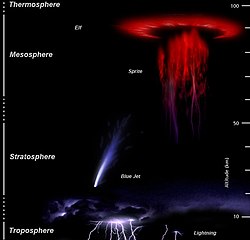|
Atmosphere-Space Interactions Monitor Atmosphere-Space Interactions Monitor (ASIM) is a project led by the European Space Agency to place cameras and X-ray/γ-ray detectors on the International Space Station to observe the upper atmosphere in order to study sprites, jets and elves and terrestrial gamma-ray flashes in connection with thunderstorms.[1] It is hoped that measurements of these phenomena from space will contribute to the understanding of Earth's upper atmosphere.[2] The ASIM components, originally planned to be completed in 2014, were launched on 2 April 2018 and mounted on the Columbus External Payload Facility on 13 April 2018.[3] Danish tech company Terma A/S is running the technical part of the project for ESA[4][5] and DTU Space (National Space Institute) from the Technical University of Denmark provides the scientific leadership of the project.[6] Mission operations will be performed by the Belgian User Support and Operations Centre (B.USOC) in Uccle, Belgium.[7][8] First results from the measurements revealed that gamma ray bursts form when powerful electric fields course through the atmosphere, just before a lightning bolt travels along the same path. These results were published in July 2019.[9] InstrumentsThe ASIM payload has a mass of 314 kg (692 lb) and consists of sub-systems CEPA and DHPU, and two scientific instruments called MXGS and MMIA:[3][7]
See also
References
External links
|